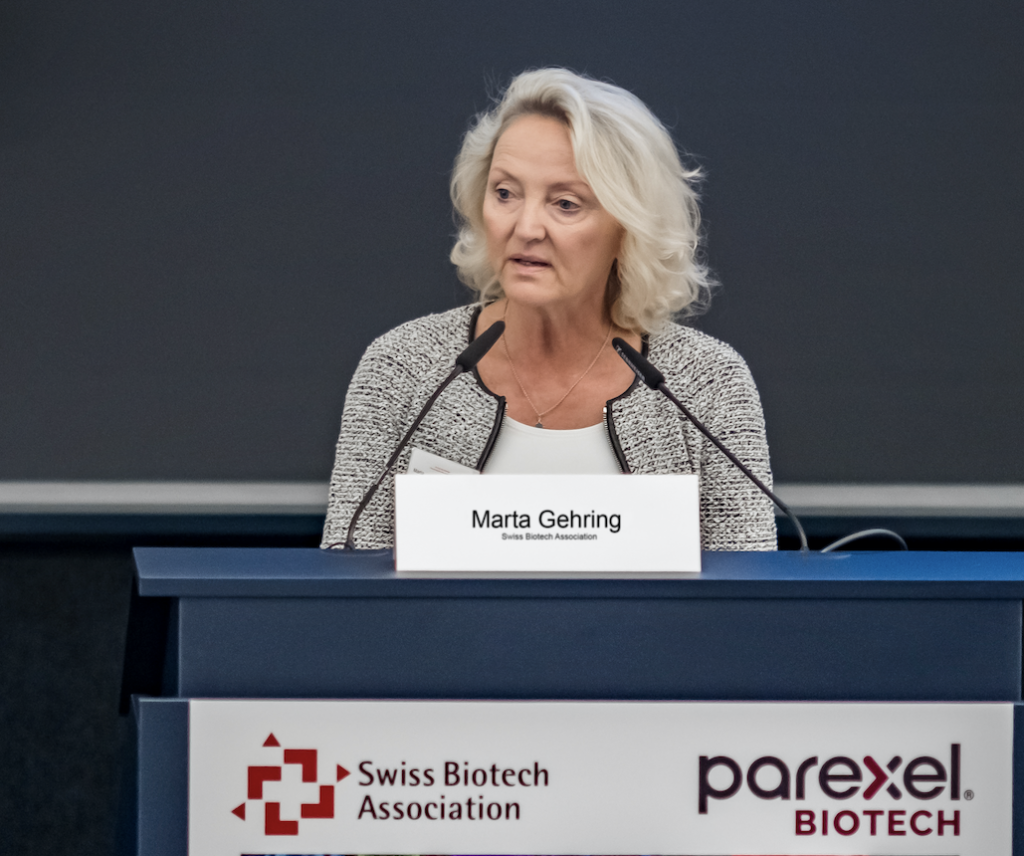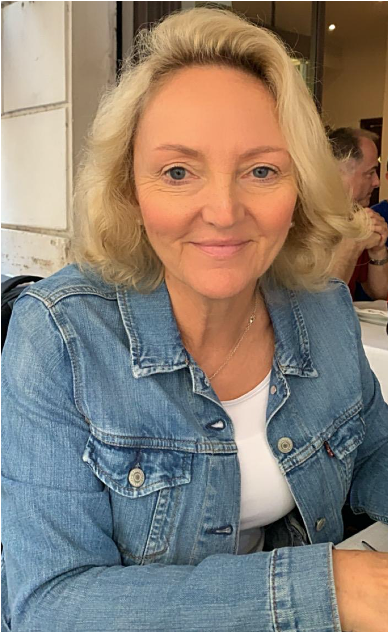
Marta Gehring is an innovation & business development strategist with track record in Biotech and Medical Devices. She is passionate about value proposition and pricing for new or nascent technologies. She has been involved in the life sciences field for more than 25 years. She also leads the Western Switzerland and Ticino part of the Swiss Biotech Association.
Marta Gehring provides you with a lot of useful tips to get into science and to attract the attention of investors. Careful – or not! – her passion for science and technologies is very communicative! Please get into her story and share it with your network.
Can you describe your path to becoming a scientist? What and / or who helped you in your professional choices?
I studied economics. I have been working in life sciences for more than twenty years and in information technology for five years. My path to working in science was driven by the opportunities presented to me. It is important for young people to join organizations that are growing – be it research centers, multinationals, startups. If the chosen organization is not growing or moving, young people will be stuck. I joined life sciences because there was a growing biotech environment at the time I started – a drive to make Switzerland a biotech hub. It was also a drive to move from animal and human derived drugs to biotech derived drugs. I absolutely loved it from day one.
It is an environment full of highly dedicated and educated people and that helped me to define my professional choice. What I found in biopharmaceuticals is a really strong interdisciplinary environment. Scientists, doctors, engineers, lawyers, communication specialists –everybody comes being very qualified, very passionate. This passion for getting things done and bring products forward was really strong.
To see a lot of people from different walks of life working together in a team around a product, a mission, was very motivating to me. There was never a dull moment.
And this environment is thriving: as shown in the 2019 annual report of the Swiss Biotech Association, the Swiss biotech industry recorded some major highlights in 2019.
Last year, Switzerland totalized CHF 97,5 billion exports of pharmaceuticals, vitamins and diagnostics. To put this into perspective: to put these numbers into perspective : in the 15 years since Angela Merkel took over as chancellor in 2005, German export to China have quintupled to just under EUR 100 billion (The Economist, “Germany’s China Policy” July 18-24, 2020, page 19)

How does your research field contribute to society?
One of the tasks as a marketing person working closely with clinical is to try to make the clinical teams think about what are the end points that really matter to the patients and to the payers. Also, to define what will make the doctors fight for you to get that product to the patients and to make the payers to accept it.
People in my field [biopharma & medtech] try to bring together the pieces to create what I call “the golden triangle”: patients, payers and healthcare professionals. Aligning the needs of a product behind these three pillars allows you to move forward. We try to focus on the development of a product that really brings value to the payer and therefore the patient.
You still see – especially in the innovation ecosystem – a lot of ideas and technologies that are great. The problem is that we don’t always know where they fit. Where is the market segment or niche? Is there a group of people willing to pay for this product? The ability to match needs and technology is how we can contribute to society.
I have been dreaming about a website of unmet needs in life sciences. People could be more likely to create technologies that meet those needs. I think this would be better than first developing a technology and find afterwards where it may fit.
How do you convince investors?

You need a fantastic pitch, a good management team and a great team of advisors all to be included in your presentation. Even if your team is small, you need to convince investors with an extremely clear message. You have to tell them the key takeaway in the first slide and to repeat it at the end. Working with public relations and communication specialists can really help a lot. They can condense scientists’ messages in a way that is digestible. Short video clips that tell a story are also a good support. They should not be used alone but can be a nice way to remind investors after a first discussion. To sum up, you convince investors with very good communication prepared with the help of professionals.
Yet, it remains true that getting investors may be harder for projects led by women.
Recently at the Bern University, I attended to seven fundraising pitches. Three of them were very good – two men, one woman. Both men were awarded first line funding – and deserved it. The woman, though, got nothing. Zina Yudina was a post-doctoral fellow at ETHZ before starting her project called “Babylat”. The idea is to provide an onsite (in-hospital) solution for enhanced pre-term nutrition with a new machine based on patented technology. Human-derived milk protein fortification could therefore be done at the hospital. She had a fantastic pitch, a good timing, good advisors. But maybe there was too much feminine in there – the topic, delivered by a woman. Zina Yudina, CEO of Babylat, is developing a unique solution for preterm nutrition. A promising research to minimize counter effects by an optimal preterm nutrition with fast weight gain.
What, in your view, is the role of public relations in supporting science and how do you use them in your own strategy?
I find it unbelievable the manner in which journalists are able to simplify a scientist’s message to make it understandable by all. The scientist will give a four sentence explanation and the journalist will rephrase it in a simplified way.
I think the ability to condense complex knowledge into highly accurate but digestible messages means that your work gains miles – it is essential.
I feel that they are many different levels of vulgarization. I feel that they are still lots of press releases and communications that don’t get to the point fast enough, that don’t have a two-line headline. However, you need that to facilitate recall. Less is more. Yes, tell me about the science but give me also a one liner that I can transform into an elevator pitch to tell someone else about it. Public relations are essential, and you have to be consistent.
“Fix the roof when it is sunny”, said IMF Director Christine Lagarde. When talking about public relations and communication, it is indeed a very good idea to set up or consolidate the fundamentals of your strategy when the context is favorable. The 2019 annual report of the Swiss Biotech Association shows that now is probably a great timing.

Should you encourage young girls to get into science, what would you say?
“Science and technologies are driving the future. Whether you want to do science, sell science, talk about science, raise money for science, why would you not jump on the bandwagon that is making the world a better place?
Social factors are very up and down but science is the only think that keeps going straight up all the time. You don’t want to miss this.
Is there something you would do differently or advise young scientists to avoid doing?
Avoid joining an organization which is not growing. Just join someone, somewhere who is growing fast. Getting to a place that is raising more money, making more sales, getting more traction, which gives young people possibilities to move forward. No matter if this is a multinational, a research center or a startup.
To move forward as a young person you have to be fearless and super self-confident. You have to believe that what you are doing is right. You should respect the rules, but you should not follow all the procedures. If you wait for every single tick to be ticked, you will wait months to be able to actually do something. Some (including some leaders at Google) have said before that if you are able to drive a project through, nobody will count the ticked boxes. Be supremely confident that what you are doing is good for the company, engage people in your work, be a good communicator.
“Believe in yourself and people will believe in you. Have doubts and people will have doubts. Ignore that you are a woman, or young, or both – this is pretty irrelevant.
Forget about it, speak up, speak your mind, don’t let anyone shout you out at meetings. Prepare your presentation so well that you are very impactful.
An anecdote to share with us about your journey as a woman in science?

Valeria Caso, a stroke neurologist and a former president of the European Stroke Organisation whom I admire very much, had a quote from Madeleine Albright – the first female United States Secretary of State in the US – on her What’sApp profile. The quote said that there is a special place in hell for women who don’t help other women. Sure, we [women] should not focus on sisterhood, but we should certainly not compete when we can collaborate. There is a lot of work to do. Sometimes women can be strong in bringing people together. We don’t always have to compete. A difference between women and men is that women often go for the experience whereas men are often going for winning a medal.

I would also want to share some tips:
- Always have your presentations and suggestions be very fact based, well documented.
- Have solid arguments for your strategy.
- Find out about your competitors. Research with the people involved what their objections may be. A lot of the objections may be about psychological matters – for example because people may think a strategy will result in them having to work harder, or will shift power to another party.
- Deal politely with objections.
- Never get stressed.
- When you get really angry after receiving a senseless writing, never reply right away. Draft you answer, amend it and send it the next day.
Want to know more about the Swiss Biotech Association as well as key facts and figures about Switzerland biotech companies? Read the 2019 annual report online.


